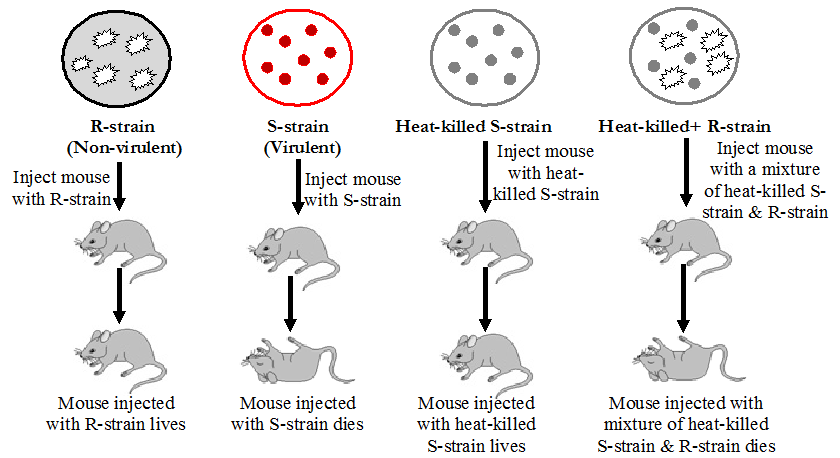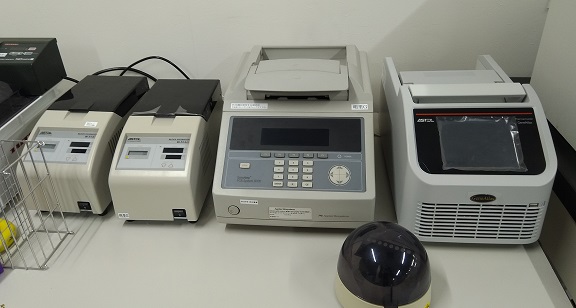The term mutation is derived from the Latin word “mutare” – which means “to change”. Thus, mutation is simply defined as the change in genetic makeup (genotype) of an organism which results in the transformation of the phenotype of the organism. Mutation is an inheritable change in the base sequence of the genome of an organism. It usually occurs in the gene or DNA of an organism. Mutation is the change in the base sequence of the DNA. Mutant genes are genesthat have undergone mutation. When mutation occurs, it results to the production of an organism or phenotype whose gene or DNA has been altered and made different from the original genetic makeup of the parent cell or organism. Such an organism with altered DNA or gene is called a mutant.
A mutant is an organism whose genome carries a mutation. Mutation is a stable, heritable change in the DNA or gene of an organism; and such an alteration in the organism’s nucleic acid molecules (DNA or RNA) eventually results in the production of a novel phenotype. Mutation can occur in any of two ways: either spontaneously or as a result of a mutagen. A mutagen is any physical, biological or chemical agent that promotes or cause mutation in an organism. Typical examples of mutagens include UV rays, ionizing radiations, and heat (which are all physical mutagens). The chemical mutagens include but not limited to intercalating agents, alkylating agents, bisulphite and nitrous acid. Mutagens alter the base sequence of nucleic acid molecules in such a way that wrong pairing of nucleotide bases during DNA replication may occur. These wrong pairing of nucleotide bases eventually results in the production of mutants.
Mutagenesis is defined as the generation of one or more mutations in an organism. Mutations can either be harmful or beneficial in a living organism. Beneficial mutations usually result in the production of phenotypes with enhanced metabolic activity, and this type of mutation mainly results in the production of novel organisms. Evolution in living organisms is usually driven by beneficial mutation since it results in the production of different varieties of species of the same organism. In harmful mutation, the change in the DNA of the organism undergoing the mutation usually results in the production of phenotypes with decreased metabolic activity; and there is usually the loss of the ability to perform or carry out certain activities in such mutants. An alteration in the amino acid sequence may adversely affect the function of a particular protein in the organism. Such a change that affects protein function is regarded as a harmful mutation. As aforementioned, mutation can either be induced by a mutagen or it may occur spontaneously without the aid of a mutagen.
In spontaneous mutation, mutation occurs spontaneously without the help of a mutagen. Spontaneous mutations (mutagenesis) are those mutations that occur naturally. These are mutations that occur as a result of natural processes or occurrences in a living cell. Spontaneous mutations which can also be called naturally occurring mutagenesis are genetic alterations in the gene or DNA of an organism that occur without any obvious exposure of the organism to mutagens (i.e. agents that damage the DNA). They are usually produced from spontaneous damages to the DNA of the cell or as a result of replication errors that occur during DNA replication in the cell.
During DNA replication in the cell, there may be occasional mis-incorporation of nucleotides by the DNA polymerase enzyme that stimulate DNA synthesis. When nucleotide molecules are inappropriately incorporated by DNA polymerases during DNA replication, there will be mismatches in the newly synthesized DNA strand. However, the proofreading ability of the DNA polymerase enzyme (especially the DNA polymerase III enzyme) has the ability to correct and remove such mismatches of nucleotide bases. Nucleotide mismatches or mistakes that occur during DNA replication as aforementioned occurs where an incorrect nucleotide base sequence is added during replication; and this kind of nucleotide mismatches lead to mutations in the next round of DNA replication particularly in the DNA strand with the incorrect nucleotide.
DNA polymerase enzyme makes mistakes when an incorrect nucleotide base is added to the growing DNA strand during DNA replication; and the presence of proofreading 3ꞌ – 5ꞌ exonuclease minimizes nucleotide mismatches during DNA replication by removing incorrectly paired bases inserted by the DNA polymerase enzyme. Spontaneous mutagenesis is usually rare and minimal in the cell, but when they occur they can cause colossal damage to the cell. Spontaneous mutagenesis also represent the error rate of DNA polymerase enzyme – in which one out of a billion DNA molecules synthesized have a mutation (1 in 109).
It is noteworthy that the DNA of the cell also has its own repair mechanisms that it uses to assuage on the effects of nucleotide mismatches. Spontaneous mutation can also occur as a result of oxidative stress in the cell. Oxidative stress damages the DNA of the cell, and when it is not taken care of by the cell, there is bound to be spontaneous mutagenesis. Superoxide and hydrogen peroxide are chemical byproducts produced by the cell; and these chemicals cause oxidative damage to the DNA of the cell. When oxidative damage caused by these chemicals is not repaired by the cell it can cause spontaneous mutation.
Induced mutations (mutagenesis) are mutations that are stimulated by exposure of a cell and/or organism to mutagens. And this type of mutation is caused by either physical or chemical agents unlike spontaneous mutation that occur naturally and without any external activation. In induced mutagenesis or mutation, the DNA of the cell interacts with external environmental factors (generally known as mutagens), and these factors or agents causes a modification of the DNA molecule as a result of the interaction. These agents increase the rate of mutation that can occur in a given cell at any given time. Physical and chemical mutagens introduce some alterations on the DNA.
In some cases, the sugar-phosphate backbone of the DNA molecule could be broken or the nucleotide bases that make up the DNA molecule could be altered during DNA replication. There are several physical and chemical agents that can act as mutagens; and these agents mainly alter the normal functioning of the DNA molecule. It is noteworthy that DNA is the only macromolecule with a repair mechanism in scenarios where DNA damages occurred. Some organisms have DNA repair mechanisms with which they use to assuage some of the effects that may arise during DNA replication. Most of these DNA repair systems reverses or restores the normal structure of the DNA without breaking its backbone while in other cases, a damaged or inappropriately inserted base or section of a nucleotide may be replaced.
Point mutations are mutations that change only one base pair of a nucleotide sequence. Point mutations are the simplest type of mutations there is; and base substitution is one of the simplest type of point mutations. Point mutations occur when the wrong base has been inserted in the place of the correct one. Point mutations are usually categorized into two types viz: transitions and transversions. In transition, one form of pyrimidine is replaced with another pyrimidine or one purine molecule is replaced with another purine molecule. Transitions are the simplest forms of mutations that occur in a cell. Transversions involves the switching of one base type for another base type. For example, pyrimidine can be switched for a purine in transversion mutations. There are several classification systems for mutations. Mutation can be classified based on their effect on the base sequence of the DNA undergoing the change or based on their effect on the encoded protein molecule.
References
Bains W (1998). Biotechnology: From A to Z. 2nd ed. Oxford University Press, New York, USA.
Bourgaize D, Jewell T.R and Buiser R.G (1999). Biotechnology: Demystifying the Concepts. Pearson Education, San Francisco, CA.
Brian Robert Shmaefsky (2006). Biotechnology 101. Greenwood Publishing Group, Inc, USA. Pp. 1-273.
Bushell M.E (1998). Application of the principles of industrial microbiology to biotechnology (ed. Wiseman, A.) Chapman and Hall, New York. Pp. 5–43.
Byong H. Lee (2015). Fundamentals of Food Biotechnology. Second edition. Wiley-Blackwell, New Jersey, United States.
Chrispeels M.J and Sadava D.E (2002). Plants, Genes, and Crop Biotechnology. 2nd edition. Jones and Bartlett Publishers, Sudbury, MA.
Clark D.P and Pazdernik N (2010). Biotechnology. First edition. Elsevier Science and Technology Books, Amsterdam, Netherlands.
Das H.K (2010). Textbook of Biotechnology. Fourth edition. Wiley edition. Wiley India Pvt, Ltd, New Delhi, India.
Dictionary of Microbiology and Molecular Biology, 3rd Edition. Paul Singleton and Diana Sainsbury. 2006, John Wiley & Sons Ltd. Canada.
Glick B.R and Pasternak J.J (2003). Molecular Biotechnology: Principles and Applications of Recombinant DNA. ASM Press, Washington DC, USA.
Godbey W.T (2014). An Introduction to Biotechnology. First edition. Woodhead Publishing, Cambridge, United Kingdom.
Jee C and Shagufta (2007). Environmental Biotechnology. APH Publishing Corporation, Darya Ganj, New Delhi, India.
Lee S.Y, Lee D.Y and Kim T.Y (2005). Systems biotechnology for strain improvement. TRENDS in Biotechnology, 23(7):349-356.
Discover more from Microbiology Class
Subscribe to get the latest posts sent to your email.





